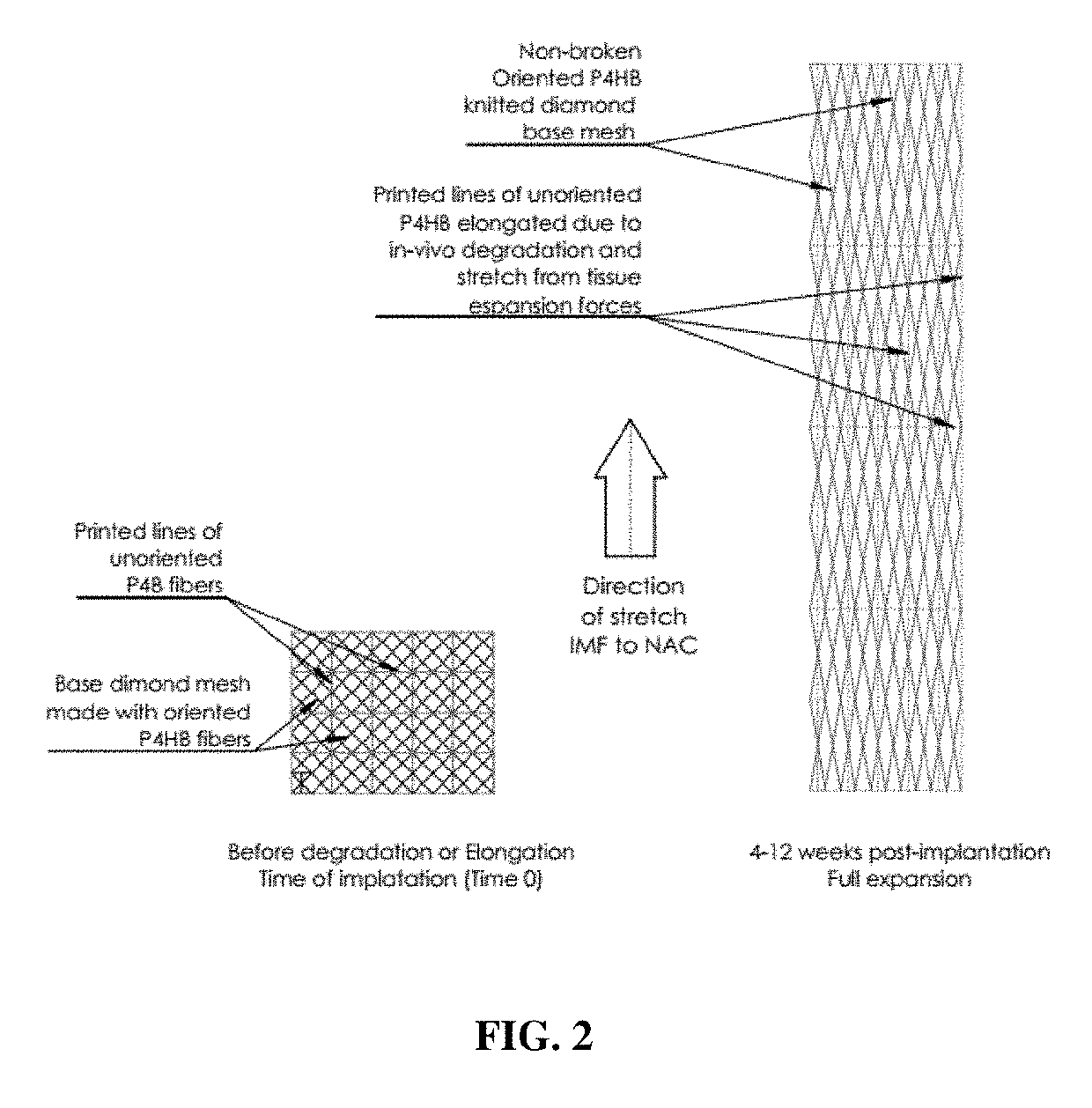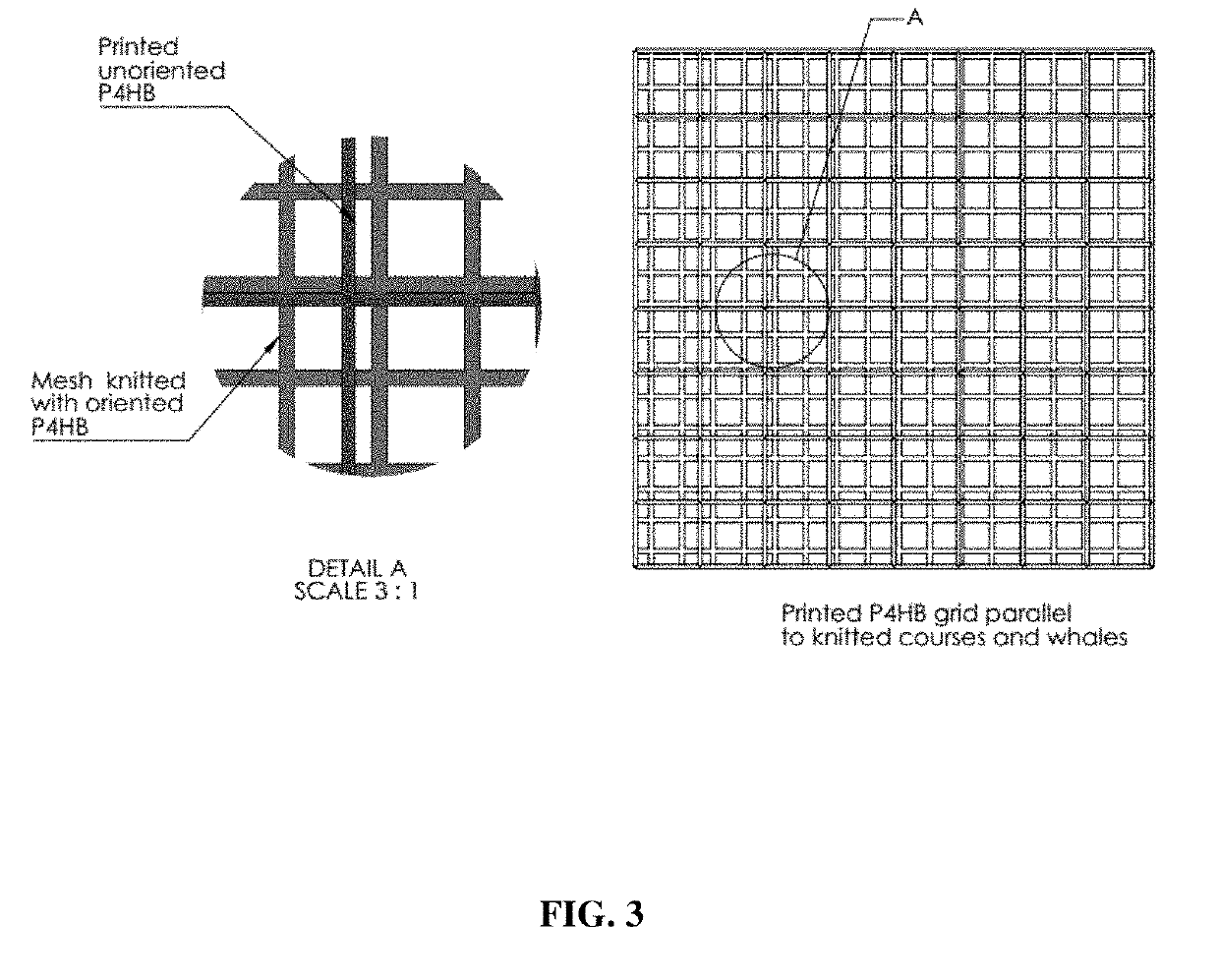Expandable absorbable implants for breast reconstruction and augmentation
a breast reconstruction and implant technology, applied in the field of surgery, can solve the problems of associating patient discomfort, etc., and achieve the effects of reducing the stress placed on the pectoralis major muscle, reducing postoperative pain, and reducing the short-term and long-term risks of infection
- Summary
- Abstract
- Description
- Claims
- Application Information
AI Technical Summary
Benefits of technology
Problems solved by technology
Method used
Image
Examples
example 1
re of Expandable Absorbable Implants for Breast Reconstruction Using a Diamond Non-Sacrificial Mesh Knitted with Oriented P4HB Monofilaments and a Printed Sacrificial Unoriented Grid of P4HB Struts
[0117]An expandable absorbable implant for breast reconstruction was prepared as follows. A non-sacrificial P4HB mesh was knit with a diamond knit pattern using oriented P4HB monofilament (Mw 340 kDa) with an average diameter of 80 microns. The average density of the knitted P4HB mesh was 130 g / m2. A fusion deposition modeling (FDM) 3D-printer was then used to deposit a square lattice of sacrificial unoriented P4HB struts over the non-sacrificial knitted mesh so that deposited sacrificial P4HB lattice was placed at a 45° angle to the mesh loops as shown in FIG. 1. The P4HB lattice pattern was transformed into an STL file, and rendered into a two-slice 3D printing profile (Matter Control) with a slice (layer) height of 0.25 mm. The average diameter of the deposited P4HB lattice was 2.9±0.1 ...
example 2
re of Expandable Absorbable Implants for Breast Reconstruction Using a Non-Sacrificial Diamond Mesh Knitted with Oriented P4HB Monofilaments Fused to a Sacrificial Grid of Unoriented P4HB Extrudate
[0119]An expandable absorbable implant was prepared using the non-sacrificial diamond knitted P4HB mesh described in Example 1, but the mesh was heat fused with a sacrificial grid prepared from unoriented P4HB extrudate. The grid was prepared using 0.6 mm diameter P4HB extrudate (Mw 230 kDa) that had been cut into 15 cm length strands, and placed in a square grid conformation on top of a 10 cm×10 cm diamond mesh lying on a 1 / 16″ thick silicone pad as shown in FIG. 4(a). The grid of P4HB extrudate was placed at a 45° angle to the mesh loops. The assembly was then inserted into a flat mold, tightened to apply pressure, and placed in a hot water bath at a temperature of 57° C. for 5 minutes to fuse the unoriented P4HB extrudate to the diamond mesh. The resulting product is shown in FIG. 4(b)....
example 3
re of Expandable Absorbable Implants for Breast Reconstruction Using a Non-Sacrificial Diamond Mesh Knitted with Oriented P4HB Monofilaments Fused to a Parallel Stack of Sacrificial Unoriented P4HB Extrudate
[0120]An expandable absorbable implant was prepared as described in Example 2, but instead of fusing the mesh to a grid of unoriented P4HB extrudate, the non-sacrificial mesh was fused to a series of parallel lines of sacrificial unoriented P4HB extrudate with a diameter of 0.6 mm as shown in FIG. 5.
PUM
| Property | Measurement | Unit |
|---|---|---|
| thickness | aaaaa | aaaaa |
| thickness | aaaaa | aaaaa |
| pore diameter | aaaaa | aaaaa |
Abstract
Description
Claims
Application Information
 Login to View More
Login to View More - R&D
- Intellectual Property
- Life Sciences
- Materials
- Tech Scout
- Unparalleled Data Quality
- Higher Quality Content
- 60% Fewer Hallucinations
Browse by: Latest US Patents, China's latest patents, Technical Efficacy Thesaurus, Application Domain, Technology Topic, Popular Technical Reports.
© 2025 PatSnap. All rights reserved.Legal|Privacy policy|Modern Slavery Act Transparency Statement|Sitemap|About US| Contact US: help@patsnap.com



